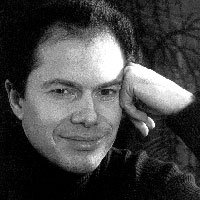|
|
  MOTIVATIONAL SPEAKER: DOMINIC ALLDIS
MOTIVATIONAL SPEAKER: DOMINIC ALLDIS
Dominic Alldis is a pianist, teacher, singer and composer.
He has a background in both classical music and jazz, appears regularly
as a soloist both at concert venues and jazz clubs. In 1989, he recorded
Night Music for Lumina Music, an album of original compositions using
the Yamaha MIDI Grand Piano and synthesizers.
In 1996, he released Turn Out The Stars, featuring songs by the legendary
jazz Bill Evans which received much critical acclaim. He is also the
author of a successful book A Classical Approach To Jazz Piano published
worldwide by Hal Leonard Corp. and lectures in keyboard improvisations
at the Royal Academy of Music in London.
Dominic Alldis gives presentations introducing music as metaphor for
corporate concerns. Music is an abstract language that uses musical
elements (melody, harmony, rhythm, etc.) to communicate ideas and
emotions.
Musical concerns, such as theme and development, skill, mastery, and
speed, consonance and dissonance, rehearsal and performance procedure,
the jazz band and the orchestra, the role of the conductor, the composer,
the improviser and the interpreter, all provide a stimulating insight
into business concerns. Such as teamwork, leadership, creativity,
mentorship and diversity, as well as providing a new vocabulary for
addressing familiar concerns.
TEAMWORK
Collaboration
Music-making is a collaborative process: the musicians work together
towards a common artistic
aim.
Listening
Listening is central to the music-making experience.
Working with diversity
The world of music is a multifarious environment that reflects the
diversity that exists in society.
The orchestra
An orchestra is an ensemble of highly trained musical specialists
that consent to be motivated by
the artistic vision and energy of a conductor.
CREATIVITY
Improvisation.
A jazz group is a hive of creativity - jazz musicians converse through
a common language that
embraces minimal structures. They also work in continually changing
teams; embrace errors as a
source of learning and alternate between soloing and accompanying
roles.
There is an incremental continuum that begins with interpretation,
is followed by embellishment, and ends with variation and improvisation.
LEADERSHIP
The conductor's or group leader's role is to coordinate a group of
musical virtuosi and to inspire and motivate them to give their best
performance.
RESULTS
The art that conceals art
An audience should experience the result of a musician's labours and
not the process.
High expectations and goal clarity
Musicians aspire to play music at the highest level with the most
talented and contribute to a tradition of excellence.
| European Speakers Bureau |
phone +32 (0)2 646 13 83 |
fax +32 (0)2 646 41 73
Rue Americaine 221, 1050 Brussels Belgium |
|







